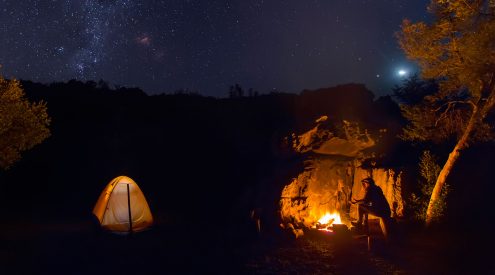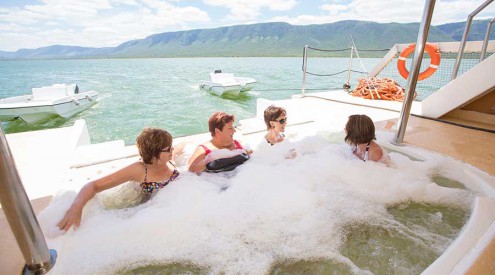This year, my attention was drawn to the Put Foot Rally, as creatively ornamented vehicles set off on an envy-evoking journey into Southern Africa. Unfortunately I was not to be taking part, but I knew I would be following the tweets and blogs that set about boasting all over the social media. I read particularly excitedly about the crews’ check-ins at Etosha National Park, Namibia as it came almost as a preview to my own journey to the ‘great place of dry water’. A week after the team of decorated automobiles cruised through the Etosha, I was following in their dust, on my own, as a portion of an investigative tour of Namibia’s shiniest gems. Etosha National Park certainly is one of them, but what I learned there was that we had better take better care of what is so generously on offer. The threats to the wellbeing of the animals and the ecosystems in this national park are presented by the people permitted to drive themselves through it, and there are rumours that this privilege may be revoked.
Not only is it Namibia’s crowning glory, the Etosha is considered one of Africa’s greatest national parks with a game-viewing potential on par with Zimbabwe’s Hwange National Park, the predator-plethoric Serengeti in Tanzania and the Masai Mara in Kenya. The identification of over 100 mammal species, 110 reptile species and a superb 340 bird species makes the park a wildlife wonder, especially considering the severe lack of water in the region. Watering holes have been constructed, assisting in the issue of drought, but water remains a precious commodity in the vast desert country. The great whiteness of the 130km long salt pan stretches out before one’s eyes, tickled by the spinning dust spirals that race across the flat surface. My guide told me that nothing exists out there, in the centre of the 72-kilometre wide used-to-be salt lake. The conditions are too harsh, with stinging winds eliminating everything not attached to the earth, making the massive area a completely barren, yet astoundingly beautiful tract of land.
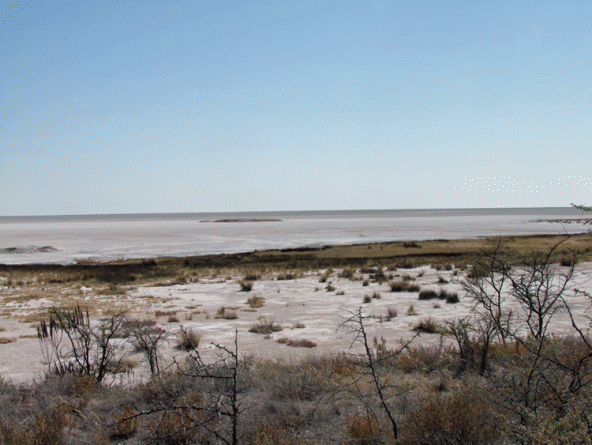
The great expanse of the Etosha Pan used to be a salt lake and after it dried up it became a safe crossing for local people, as wild animals avoid the barren land. Photo by Chloe Cooper
At present there is a variety of accommodation options available for visitors wanting to overnight in the wild; it is free of the risk of malaria, making it family-friendly and an admin-free trip to organise; there are petrol stations, viewing points and convenience stores, which all contribute to the pleasing ease of an Etosha safari. Such suitability extends its client base to just about anyone who is enticed by the idea of game viewing in Africa. This is where the problem originates. The strict rules in place in the park are there to protect the environment, to ensure the safety of both people and animals, to maintain the carefully constructed interactive setting and to teach visitors how to respect wildlife. However, after chatting to my guide at Ongava Game Reserve, he revealed, to my surprise and sadness, that there are rumours about abandoning Etosha’s self-drive option altogether. Tourism (indeed that generated by the Etosha) contributes second-most highly to Namibia’s GDP, and it came as a shock that the source bringing the most income into the park could be eliminated due to the disruption it leads to.
In 2011, a blaze started due to a badly managed charcoal kiln and it leapt with the gusting wind, searing 370 000 hectares of land and killing 30 rhinos, 50 giraffes and seven elephants among an array of smaller, more vulnerable species. Fires started by tourists at campsites are a real threat when little care is taken to extinguish them properly. Another problem related to the campsites, but extending further afield is the issue of littering. Disposing of rubbish anywhere other than in allocated bins is a reflection of the lazy disregard of the people committing the crime. Anywhere in the world, this is a disgusting and dangerous habit, but to drive through a National Park such as Etosha and find unnaturally colourful items reflecting the sunlight or wrapping themselves around the branches of an umbrella acacia is disturbing enough to want to disallow visitors from entering the park at all.
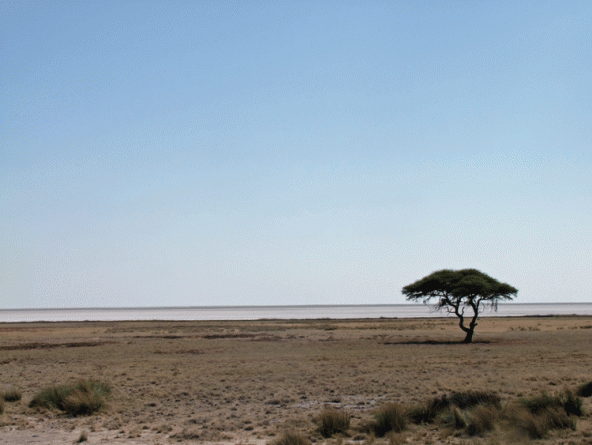
The south western region of the Etosha has a vastly flat silhouette interrupted by singular, tall acacias. Photo by Chloe Cooper
Idiocy such as disembarking one’s vehicle at watering holes or viewing points poses such risks and happens far too frequently in the park. Etosha is huge and the roads are long – it’s all a part of the beauty there, but to be rudely covered in dust by a speeding sedan whose drivers have lost patience has become far too common a problem. Wild dogs have not existed in the Etosha since the mid-twentieth century, one of the reasons being the possibility that one of Africa’s rarest carnivores will end up as road kill.
Speeding, littering, uncontrolled fires and unauthorised disembarking of vehicles are some of the primary causes for all disturbances in the Etosha National Park. These have presented themselves as so counter-productive to the park’s success that not even the financial influx generated by self-drivers shines brightly enough to shadow the shortcomings they present. I took it as a word of warning when I left the great desert country, and as I stand now, I absolutely agree that the sorts of people breaking such simple rules for self-driven safaris do not deserve the magnificent gift of Etosha. Sadly, to eliminate them would be to eliminate us all…
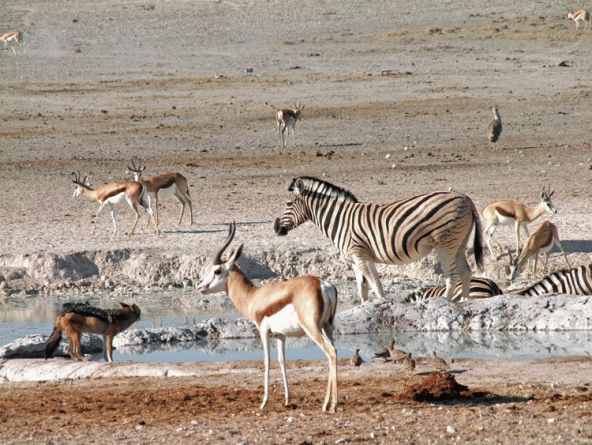
The waterholes attract a variety animals to drink in the arid north west. The Etosha is one of the few places I have seen such a mixture of species at once. Photo by Chloe Cooper

Namibia can be considered the safe haven for the endangered black rhino. We saw this wanderer ambling through the veld in the heat of the day, which was an expected and quite an extraordinary sight. Photo by Chloe Cooper

The Burchells zebra is one of the flagship species in the Etosha Park, causing entertaining African roadblocks and superb photographic opportunities. Photo by Chloe Cooper
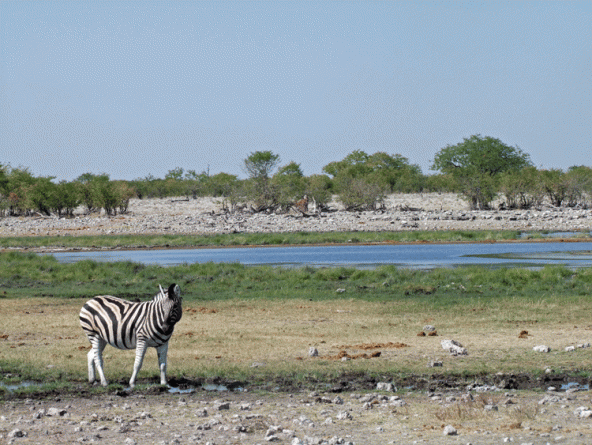
The Rietfontein waterhole is one with more greenery than most, creating the effect of an oasis in the white, dusty park. Here we were lucky enough to watch a tawny eagle sidle up to a bateleur on an overhanging branch. Photo by Chloe Cooper
This post is brought to you by Sun Safaris, organisers of Southern and East African safaris. Check out Sun Safaris on Facebook, Twitter and Pinterest










